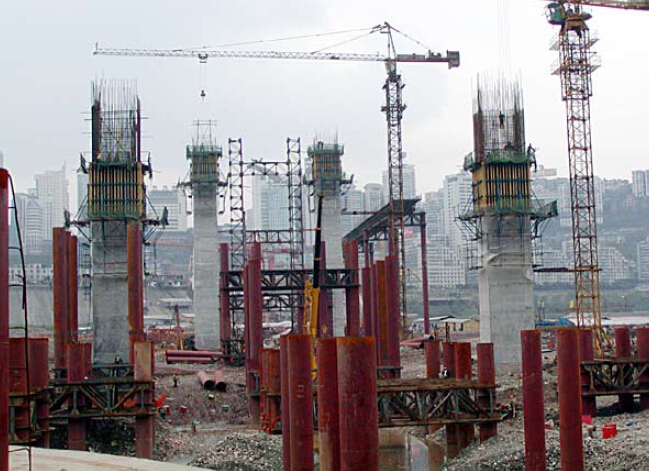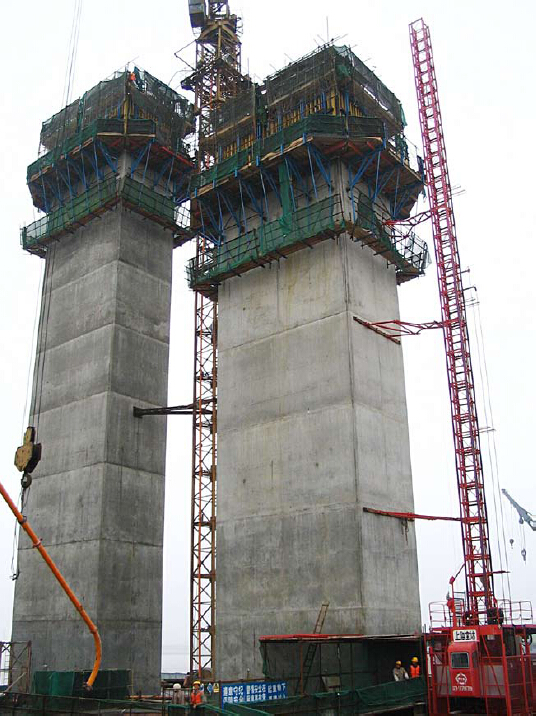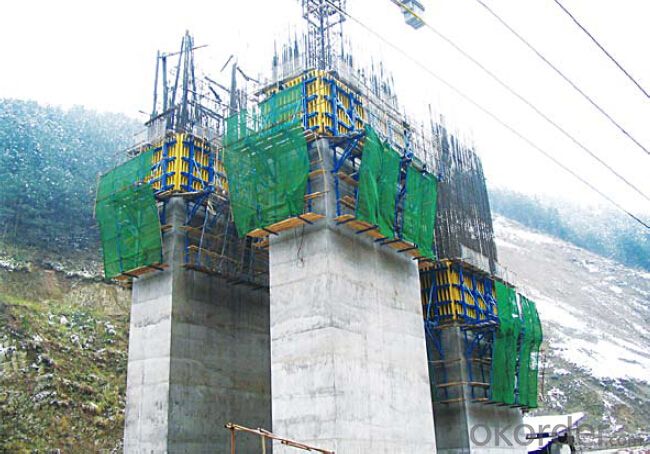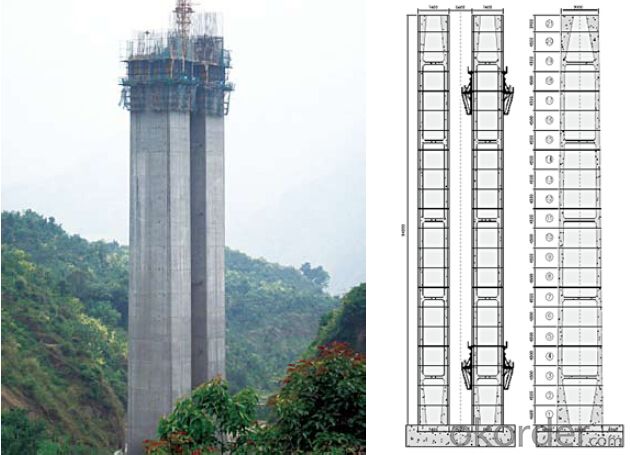Climbing Bracket CB240 for formwork and scaffolding system
- Loading Port:
- Tianjin
- Payment Terms:
- TT OR LC
- Min Order Qty:
- 50 m²
- Supply Capability:
- 1000 m²/month
OKorder Service Pledge
OKorder Financial Service
You Might Also Like
Climbing Bracket CB240 & CB210
They are framework brackets for supporting large-area wall formwork.
Typical applications for the CB240&CB210 are pier and column/shear wall/core walll/ in the
building.
CB210 has smaller size than CB240, it will be cost effective in some condition.
Characteristics:
◆ High bearing capacity
The high loading capacity of the brackets allow very large scaffold units. This saves the number
anchor points required as well as reducing climbing times.
◆ Simple moving procedure by crane
Through the strong connection of formwork together with the climbing scaffold, both can be moved
as a single climbing unit by crane. Thus valuable time-savings can be achieved.
◆ Fast striking process without a crane
With the retrusive set, large formwork elements can also be retracted quickly and a minimum of
effort.
◆ Safe with work platform
The platforms have assembled firmly with bracket and will be climbing together, without scaffolding
but can work safely in spite of your high location.


- Q: How does steel formwork contribute to the safety of construction workers?
- Steel formwork contributes to the safety of construction workers by providing a sturdy and durable framework for concrete pouring. It offers better structural stability, reducing the risk of collapses or accidents during the construction process. Additionally, steel formwork is fire-resistant and can withstand extreme weather conditions, ensuring the safety of workers even in challenging environments.
- Q: How does steel formwork affect the overall energy efficiency of a structure?
- Steel formwork can significantly improve the overall energy efficiency of a structure. It provides a durable and reusable framework for concrete pouring, reducing material waste and construction time. The precise fit of steel formwork minimizes the need for additional insulation, resulting in better thermal performance and reduced energy consumption for heating and cooling. Additionally, its strength and stability allow for the construction of thinner walls and slabs, maximizing the usable space and minimizing the amount of materials required. Thus, steel formwork positively impacts the energy efficiency of a structure by reducing energy consumption and promoting sustainable construction practices.
- Q: How does steel formwork contribute to the overall aesthetics of the structure?
- There are several ways in which steel formwork enhances the overall aesthetics of a structure. Firstly, it is renowned for its high-quality finish and smooth surfaces, which create sleek and visually pleasing concrete structures. The clean and uniform appearance achieved with steel formwork adds to the aesthetic appeal of the final product. Furthermore, steel formwork allows for greater design flexibility and creativity. Architects and designers can take advantage of the versatility of steel to create intricate shapes and curves that would be challenging with other formwork materials. This flexibility opens up possibilities for unique and attention-grabbing architectural features, enhancing the overall visual appeal of the structure. In addition, steel formwork provides a consistent and precise formwork system, resulting in accurate dimensions and sharp edges. This attention to detail contributes to the overall crispness and professionalism of the structure's aesthetics. Whether it's for exposed concrete walls, columns, or beams, steel formwork ensures a high level of precision and alignment, creating a polished and refined appearance. Moreover, steel formwork offers durability and longevity, making it an ideal choice for structures that require long-term aesthetics. Unlike other formwork materials that may deteriorate over time, steel is resistant to weathering, corrosion, and warping. This ensures that the structure maintains its aesthetic appeal for years to come, without compromising its structural integrity. Lastly, steel formwork promotes sustainability by being easily reusable, reducing waste. Construction companies can minimize their environmental footprint by using the same steel formwork for multiple projects. This emphasis on sustainability aligns with the modern design aesthetic that values eco-friendly practices, making steel formwork an attractive choice for architects and clients alike. To sum up, steel formwork contributes to the overall aesthetics of a structure through its high-quality finish, design flexibility, precise formwork system, durability, and sustainability. These factors combine to create visually appealing, sleek, and polished structures that stand out in their architectural beauty.
- Q: What is the maximum height that steel formwork can be used for?
- The maximum height that steel formwork can be used for depends on various factors such as the design of the formwork system, the load-bearing capacity of the steel components, and the stability requirements. However, in general, steel formwork can be used for constructing structures of considerable height, ranging from a few meters to several stories high. It is essential to consult with structural engineers and follow relevant safety guidelines to determine the specific maximum height for each project.
- Q: How does steel formwork contribute to the overall sustainability of a construction project?
- Steel formwork contributes to the overall sustainability of a construction project in several ways. Firstly, steel formwork is reusable, which reduces the consumption of raw materials and reduces waste generation. This not only lowers the project's environmental impact but also saves costs in the long run. Secondly, steel formwork provides a durable and robust solution, ensuring a longer lifespan and reducing the need for frequent replacements. Additionally, steel formwork is highly versatile and can be easily adjusted and modified to accommodate various design changes, reducing the amount of material waste. Lastly, steel formwork allows for efficient and faster construction, reducing the project's energy consumption and minimizing disruption to the surrounding environment.
- Q: Can steel formwork be used for single-sided formwork applications?
- Steel formwork is an ideal option for single-sided formwork applications. Its durability and strength make it suitable for various construction projects, including those requiring single-sided formwork. This type of formwork is commonly used when only one side of the concrete structure is accessible, such as when constructing retaining walls, columns, or beams against existing structures. By providing the necessary support and stability, steel formwork holds the concrete in place until it cures and hardens. Its high level of accuracy and precision ensures that the concrete structure is formed correctly and meets the desired specifications. Moreover, steel formwork can be easily assembled and disassembled, facilitating efficient and rapid construction. Another advantage is that it can be reused multiple times, making it a cost-effective choice for single-sided formwork applications. All in all, due to its strength, durability, accuracy, and efficiency, steel formwork is a reliable and suitable option for single-sided formwork applications.
- Q: Can steel formwork be used in extreme weather conditions?
- Yes, steel formwork can be used in extreme weather conditions. Steel is a durable and strong material that can withstand harsh weather conditions such as extreme heat, cold, rain, and wind. Unlike other materials like wood or plywood, steel formwork is not affected by moisture or temperature variations, making it suitable for use in extreme weather conditions. Additionally, steel formwork provides better stability and structural strength, ensuring the safety and integrity of the construction project even in adverse weather conditions. However, it is important to consider the proper protection and maintenance of steel formwork to prevent corrosion or damage that can occur over time due to exposure to extreme weather conditions.
- Q: Can steel formwork be used for projects with complex geometries?
- Yes, steel formwork can be used for projects with complex geometries. Steel formwork is known for its versatility and strength, making it suitable for projects that require intricate shapes and designs. It can be easily customized and fabricated to meet the specific requirements of complex geometries, ensuring a precise and efficient construction process. Additionally, steel formwork offers excellent durability, allowing it to withstand the pressures and stresses associated with complex structures.
- Q: How does steel formwork contribute to the overall quality of the concrete finish?
- Steel formwork contributes to the overall quality of the concrete finish in several ways. Firstly, steel formwork provides a strong and rigid framework for the concrete to be poured into. This ensures that the concrete is poured in the desired shape and dimensions, resulting in a more accurate and precise finish. Unlike other types of formwork materials, such as wood or plastic, steel formwork does not warp or bend under the weight and pressure of the concrete. This prevents any deformations or imperfections in the final concrete surface. Secondly, steel formwork allows for smoother and more even concrete surfaces. The smooth surface of steel formwork prevents the formation of air pockets or voids in the concrete, resulting in a smoother finish. This is particularly important for concrete surfaces that will be exposed or visible, such as architectural elements or decorative finishes. Furthermore, steel formwork provides better support and stability during the pouring and setting process of the concrete. The rigid structure of steel formwork ensures that the concrete is properly contained and supported, reducing the risk of cracks or other structural issues. This helps to maintain the integrity and durability of the concrete finish over time. Additionally, steel formwork is highly durable and reusable. Unlike other types of formwork materials that may need to be replaced after a few uses, steel formwork can be used multiple times without compromising its quality. This not only reduces costs but also ensures consistent and high-quality concrete finishes throughout various construction projects. In conclusion, steel formwork plays a crucial role in achieving a high-quality concrete finish. Its strength, stability, and smooth surface contribute to the accuracy, precision, and durability of the final concrete surface. By providing a reliable and reusable framework, steel formwork helps to create consistent and aesthetically pleasing concrete finishes.
- Q: How does steel formwork handle different concrete surface slip resistance?
- Steel formwork handles different concrete surface slip resistance by providing a stable and rigid structure that supports the concrete during its setting and curing process. The smooth surface of steel formwork allows for easy removal and helps achieve a consistent concrete finish. Additionally, steel formwork can be treated with various coatings or textures to enhance slip resistance if required.
Send your message to us
Climbing Bracket CB240 for formwork and scaffolding system
- Loading Port:
- Tianjin
- Payment Terms:
- TT OR LC
- Min Order Qty:
- 50 m²
- Supply Capability:
- 1000 m²/month
OKorder Service Pledge
OKorder Financial Service
Similar products
Hot products
Hot Searches



















